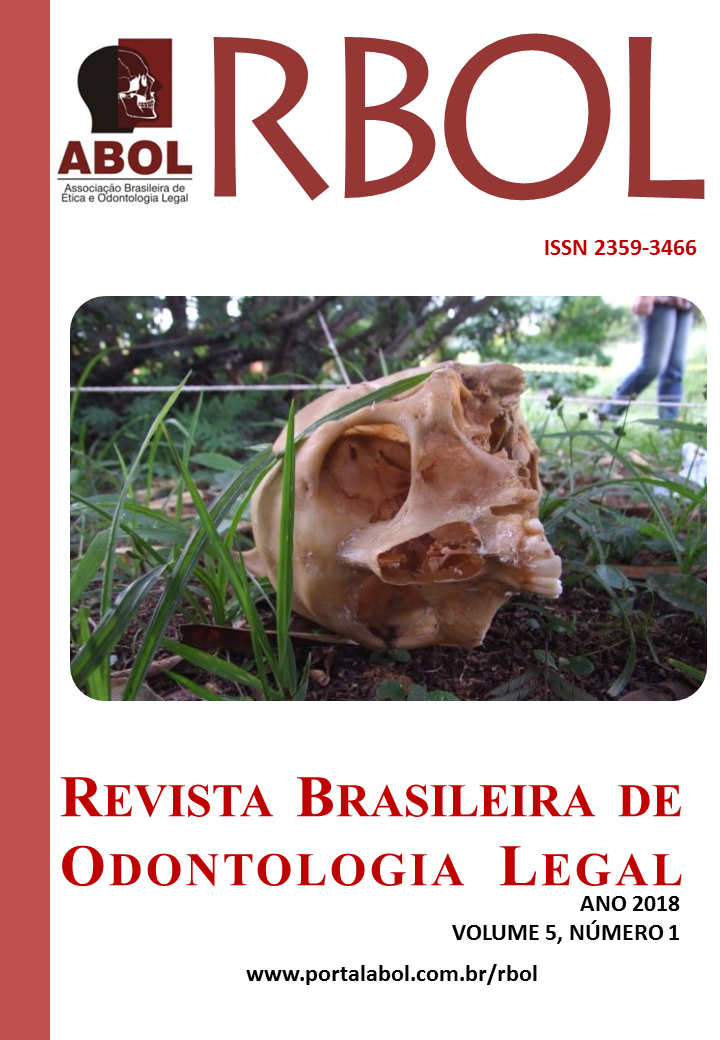USE OF QR CODE AS PERSONAL IDENTIFICATION OF COMPLETE DENTURES – LITERATURE REVIEW
DOI:
https://doi.org/10.21117/rbol.v5i1.160Palavras-chave:
Complete denture, Denture identification marking, Forensic dentistry, Forensic sciencesResumo
Different methods of identification of complete dentures have been described as well as the importance of its use. The QR code has recently been highlighted as a simple and effective novelty for this purpose, but its use in daily clinical practice is still poorly reported. The aim of this study was to perform a literature review regarding the use of the QR code as a system of personal identification in complete dentures. An electronic search was performed in the Pubmed database in June 2017. A specific search strategy was developed and executed, considering as inclusion criteria studies published in the last 10 years. After selecting and reading titles and abstracts, 8 studies were included in the final list. The use of the QR code in complete dentures has been described as simple, efficient and capable of storing a considerable amount of information. Some laboratory studies have tested the resistance of the QR code covered by acrylic resin against adverse conditions such as heat, chemicals and fractures, which, in general, confirmed the feasibility of using this identification alternative. It is important to point out the need for dissemination among dentistry students and patients regarding the benefits and legal importance of having a complete denture identification system.
Referências
Aguloglu S, Zortuk M, Beydemir K. Denture barcoding: a new horizon. Br Dent J. 2009; 206(11):589–590. http://dx.doi.org/10.1038/sj.bdj.2009.477
Alencar MJS, Albrecht N, Andrade VM, Lima LS, Letieri AS. Métodos de identificação em Próteses Dentárias: uma revisão de literatura. Rev. Bras. Odontol. 2011; 68(1):54-58.
Bali SK, Naqash TA, Abdullah S, Mir S, Nazir S, Yaqoob A. Denture identification methods: A review. Int J Health Sci Res. 2013; 3(4):100-104.
Basavanna JM, Jain A, Misra SK. Denture barcoding in forensic dentistry: A future option. J Forensic Dent Sci. 2016; 8(1):52-55. http://dx.doi.org/10.4103/0975-1475.176952
Datta P, Sood S. The various methods and benefits of denture Labeling. J Forensic Dent Sci. 2010; 2(2):53-58. http://dx.doi.org/10.4103/0975-1475.81281
Dineshshankar J, Venkateshwaran R, Vidhya J, Anuradha R, Mary GP, Pradeep R, et al. Denture bar-coding: An innovative technique in forensic dentistry. J Pharm Bioall Sci. 2015; 7(2):350-353. http://dx.doi.org/ 10.4103/0975-7406.163450
Fonseca GM, Cantín M. Commentary on: Ragavendra TR, Mhaske S, Gouraha A, Yuwanathi M, Kamath KP, Saawarn S, Kasetty S. Quick response code in acrylic denture: will it respond when needed? J Forensic Sci. 2015; 6(1):259. http://dx.doi.org/10.1111/1556-4029.12636
Jain AR, Sindhu P, Krishnan CJV, Chandran CR. A new alternative technique for denture identification. World J Dent. 2015; 6(3):188-192. http://dx.doi.org/10.5005/jp-journals-10015-1340
Mahoorkar S, Jain A. Denture identification using unique identification authority of India barcode. J Forensic Dent Sci. 2013; 5(1):60‑63. http://dx.doi.org/10.4103/0975-1475.114545
Nalawade SN, Lagdive SB, Gangadhar SA, Bhandari AJ. A simple and inexpensive bar-coding technique for denture identification. J Forensic Dent Sci. 2011; 3(2):92-94. http://dx.doi.org/10.4103/0975-1475.92155
Poovannan S, Jain AR, Krishnan CJ, Chandran CR. An in vitro evaluation of the reliability of QR code denture labeling technique. J Forensic Dent Sci. 2016; 8:179-184. http://dx.doi.org/10.4103/0975-1475.195116
Ragavendra TR, Mhaske S, Gouraha A, Yuwanathi M, Kamath KP; Swati Saawarn S, et al. Quick response code in acrylic denture: Will it respond when needed? J Forensic Sci. 2014; 59(2):514-516. http://dx.doi.org/10.1111/1556-4029.12331
Rajendran V, Karthigeyan S, Manoharan S. Denture marker using a two-dimensional bar code. J Prosthet Dent. 2012; 107(3):207-208.
Richmond R, Pretty IA. A range of postmortem assault experiments conducted on a variety of denture labels sed for the purpose of identification of edentulous individuals. J Forensic Sci, 2009; 54(2): 411-414. http://dx.doi.org/10.1111/j.1556-4029.2009.00987.x
Sudheendra US, Sowmya K, Vidhi M, Shreenivas K, Prathamesh J. 2D Barcodes: a novel and simple method for denture identification. J Forensic Sci. 2013; 58(1):170-172. http://dx.doi.org/10.1111/j.1556-4029.2012.02275.x
Downloads
Publicado
Edição
Seção
Licença
Os autores deverão encaminhar por email, devidamente assinada pelos autores ou pelo autor responsável pelo trabalho, a declaração de responsabilidade e transferência de direitos autorais para a RBOL, conforme modelo abaixo.
DECLARAÇÃO DE RESPONSABILIDADE E TRANSFERÊNCIA DE DIREITOS AUTORAIS
Eu (Nós), listar os nomes completos dos autores, transfiro(rimos) todos os direitos autorais do artigo intitulado: colocar o título à Revista Brasileira de Odontologia Legal - RBOL.
Declaro(amos) que o trabalho mencionado é original, não é resultante de plágio, que não foi publicado e não está sendo considerado para publicação em outra revista, quer seja no formato impresso ou no eletrônico.
Declaro(amos) que o presente trabalho não apresenta conflitos de interesse pessoais, empresariais ou governamentais que poderiam comprometer a obtenção e divulgação dos resultados bem como a discussão e conclusão do estudo.
Declaro(amos) que o presente trabalho foi totalmente custeado por seus autores. Em caso de financiamento, identificar qual a empresa, governo ou agência financiadora.
Local, data, mês e ano.
Nome e assinatura do autor responsável (ou de todos os autores).

